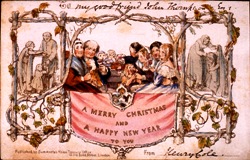Distant Thunder
 In the 19th Century Christmas cards became all the rage. As early as 1822 the fashion for sending home-made Christmas cards in the US put such a strain on the postal service that 16 extra postmen had to be taken on and the Superintendent of Mails in Washington, DC petitioned Congress to limit the exchange of Christmas cards by post. But the tide was unstoppable.
In the 19th Century Christmas cards became all the rage. As early as 1822 the fashion for sending home-made Christmas cards in the US put such a strain on the postal service that 16 extra postmen had to be taken on and the Superintendent of Mails in Washington, DC petitioned Congress to limit the exchange of Christmas cards by post. But the tide was unstoppable.
When Sir Henry Cole, who went on to arrange the Great Exhibition in 1851 and oversaw the inauguration of the Victoria and Albert Museum, commissioned John Calcott Horsley in 1843 to produce a printed Christmas card, the idea of commercially produced Christmas cards really took hold. The rest is history. Christmas now ranks top of the pops in the commercial card industry.
Surprisingly, the idea of exchanging Christmas cards doesn’t seem to have taken off amongst the early geologists. There don’t appear to be any Christmas cards from mid-19th C members of the Geol. Soc. in the archives. And it’s only in the last few years that the Geol. Soc. itself hit on the idea of producing its own set of Christmas cards for sale.
Nevertheless, the exchanging of handmade Christmas cards was not entirely unknown within the geological community. For example, F J North (1889-1968), Keeper of Geology at the National Museum of Wales from 1915-1958, distributed Christmas cards in 1944 made using fragments of a William Smith map (see Distant Thunder, January 2011). Another who took up the idea was the geologist J V Harrison (1892-1972). Harrison spent 20 years exploring vast tracks of country in Persia (now Iran), Central and South America, Borneo and the West Indies for the Anglo-Persian Oil Company, the fore-runner of BP, before joining the Geology Department at Oxford University in 1938.
Although Harrison’s cards, produced in the 1930s and illustrated with his own photographs taken in the wilds of Persia (now Iran), were not exactly seasonal, they did reflect Harrison’s great passion for carrying out geological fieldwork in remote places and as Harrison’s entry in the Dictionary of National Biography puts it ‘under the most arduous conditions that could be arranged’. At Oxford Harrison’s capacity for rugged fieldwork remained legendary. Former undergraduates recall arriving for a field trip on Arran and seeing Harrison, then in his mid-40s, tall, thin, bearded and wearing a kilt, rise out of the mist like an Old Testament prophet , and then proceed to out-walk them all.
Harrison’s production of Christmas cards seems to have ceased after he arrived in Oxford, but his Christmas communications did not. They just took on another form. Instead of sending cards to his colleagues, he arranged the delivery of Christmas trees cut from his own woods at his home in Kennington, Oxford to the children of Department staff. This green alternative must have delighted the recipients. And as the trees were probably delivered by hand, overburdened postal workers must have been delighted too!
Season’s greetings to all!
Acknowledgements
J V Harrision’s Christmas cards can be found in the Special Collections section of the BGS GeoScenic website http://geoscenic.bgs.ac.uk/asset-bank/action/viewHome ; I’m grateful to David (E A) Vincent and Philip Powell for sharing their personal recollections of Harrison. Other sources of information include the Geological Society librarians, Wendy Cawthorne and Michael McKimm; the Geological Society Archivist, Caroline Lam; the entry for John Vernon Harrison by E A Vincent and information about the history of Christmas Cards available from the website www.ideafinder.com.
If the past is the key to your present interests, why not join the History of Geology Group (HOGG)? For more information and to read the latest HOGG newsletter, visit: www.geolsoc.org.uk/hogg, where the programme and abstracts from the Conference on Geological Collectors and Collecting are available as a pdf file free to download.
*Nina Morgan is a geologist and science writer based near Oxford.